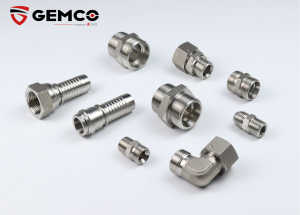Stainless steel has a high resistance to pitting and staining caused by corrosion, also known as oxidation. There are two main types of stainless steel used in industrial and hydraulic fittings, SS 304 and SS 316. The difference is that 304 contains 18% chromium and 8% nickel, while 316 contains 16% chromium, 10% nickel and 2% molybdenum (also known as moly). The molybdenum is added to improve corrosion resistance, particularly to chlorides such as seawater and de-icing salts. أيضًا, unlike the iron in carbon steel, chromium is not susceptible to oxidation.
Why use stainless steel hydraulic fittings?
Hydraulic hose assemblies in hydraulic systems have to withstand varying pressures and temperatures during use. Cyclical changes in temperature and pressure cause parts to expand and contract. As a result, selecting inappropriate materials for hose fittings and adapters will degrade your system over time. Ultimately, this can lead to the failure of the entire hydraulic system.
Hydraulic hose fittings and adapters made from various grades of stainless steel are less prone to micro-cracking. This makes them a better choice for the job and improves the longevity of the hydraulic system.
Industries & Applications
Applications that require stainless steel hydraulic hose fittings and apdaters to be corrosion resistant include:
Petrochemical processing
Oil and Gas Industries
Food & Beverage manufacturing
Medical and instrument
Agricultural fertiliser
Marine & Boating Industries
Alternative Engery
Military
Aerospace
Railroad Equipment

Stainless steel Hydraulic Hose Fittings
إذا كنت بحاجة إلى معرفة المزيد عن تركيبات الخراطيم الهيدروليكية, لا تتردد في الاتصال بنا.
توفر شركة Gemco موصلات هيدروليكية مقابلة للمجال الهيدروليكي في العالم, وهي شركة تصنيع عالية الجودة للتجهيزات الهيدروليكية.
 شعار موقع جيمكو
شعار موقع جيمكو